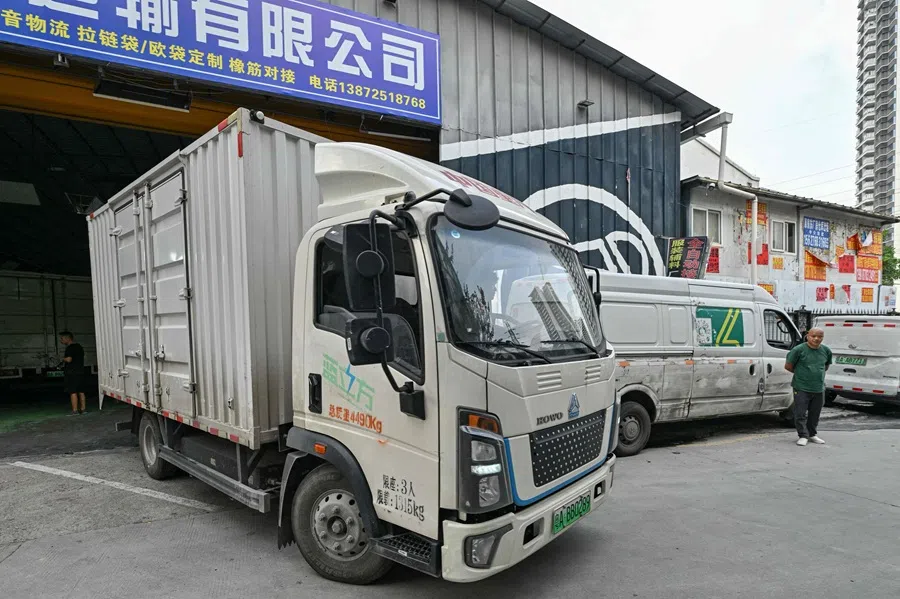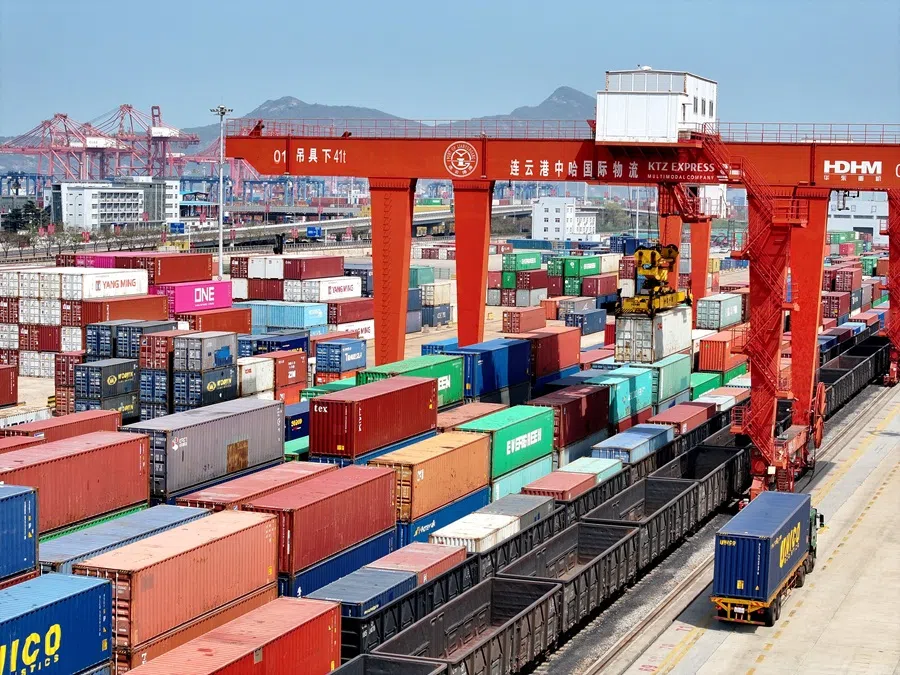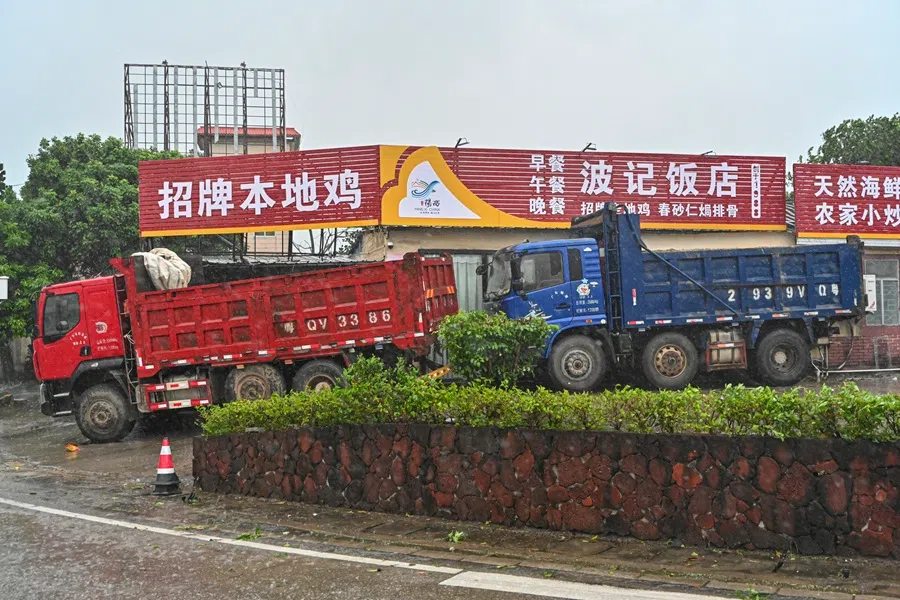Less goods, fewer shipments: China’s truck drivers first to feel the pulse of the economy
Chinese truck drivers are experiencing a significant downturn in their industry despite official reports of economic growth. Lianhe Zaobao correspondent Li Kang speaks with these struggling truck drivers to find out more.

“In the past, once I reached my destination, I would go directly to a hotel for the night and have meals at restaurants. Nowadays, I sleep and prepare my meals in the truck, and there is nowhere to have a shower.”
As the trucking industry has slumped in the past two years, 53-year-old truck driver Chen Yong is using various means to tighten his belt. Even in mid-summer, he rarely sleeps overnight in hotels and will make do by sleeping in his truck three nights in a row. Chen told Lianhe Zaobao that his long-haul Hubei–Guangxi round trips have gone down from four to five a month in previous years, to just three a month this year.
Driving at a loss
Truck drivers, who spend most of their lives on the roads, are an important link that connects the different parts of China’s economy. They are also among the first groups of workers to be affected by shifts in the economy. Although China’s economy has withstood external pressures and grew a remarkable 5.3% in the first half of 2025, truck drivers have clearly felt the chills.
Their monthly incomes have fallen from over 20,000 RMB during Covid-19 to just over 10,000 RMB.
This year, Chen must be frugal when he drives from Guangxi back to Hubei just to break even. His operating cost is 200 RMB (US$28) per tonne. However, trucking platform companies suppress transportation rates, often starting as low as 160 RMB per tonne. If no one accepts the job, the price is gradually raised to 170 RMB, then 180 RMB per tonne — until “someone caves in and takes the order”.
In past years, Chen usually landed a job order within a day, but this year, he has had to wait three days sometimes, only to end up accepting one at a loss. He would then need to calculate the fuel consumption and expressway tolls for the 1,200-kilometre return leg, and save money on sections of the journey by using national highways instead.

Despite careful calculations, loss is never completely avoidable. Chen helplessly said, “In the past, I could find a shipment from the job announcement blackboard in the logistics park with my eyes closed, make the entire trip on expressways, and always make some money. Now, I could even lose money if I am unlucky.”
Impact from downturn in several industries
Chen is not an isolated example. Two other truck drivers from Hebei and Anhui, respectively, also said that they too, have been hit by the drop in long-haul shipments in the past two years. Their monthly incomes have fallen from over 20,000 RMB during Covid-19 to just over 10,000 RMB.
Official data show that there are currently about 38 million truck drivers in China. According to the 2025 Truck Driver Employment Survey Report published by the China Federation of Logistics & Purchasing in July 2025, truck drivers generally responded that their overall income in 2024 had fallen compared with 2023. Among them, self-employed drivers’ income has shrunk by nearly 80%, while employed drivers’ income has fallen by about half.
Zhao, the truck driver from Hebei, was contracted to transport medication for a large pharmaceutical company during Covid-19. After the pandemic, however, the company encountered difficulties, and he was laid off and lost his stable source of work.
Wei, the other truck driver from Anhui, transported raw materials for small chemical plants, but many such plants have been ordered to shut down in recent years due to environmental issues, resulting in him losing half of his work. Chen, who transports moulds for construction sites, has seen his volume of work diminish due to the downturn in the real estate industry.
... the ‘zero-RMB down payment’ model — where trucks are purchased with no upfront cost — is fuelling the fierce competition in the trucking industry.
Even as freight demand shrinks, easier access to truck loans has flooded the market with drivers, all chasing a dwindling number of jobs. Zhao lamented in his WeChat Moments that “while cargo owners previously booked trucks in advance, truck drivers are now lining up for work everywhere”.
The other two drivers said the ‘zero-RMB down payment’ model — where trucks are purchased with no upfront cost — is fuelling the fierce competition in the trucking industry. While some truck drivers take on jobs no matter how low the trucking fees are so that they can make their monthly loan repayments, others are reluctant to take on jobs for no profit, preferring to leave their trucks idle at home while they wait.

Wei, who has been in the trade for 30 years and has changed his truck four times, wryly said that he is doing “just a little better than farming”. He added that drivers in the trucking industry will upgrade to a bigger truck when they make money, but “while we support the livelihoods of those upstream and downstream, we cannot even make a living for ourselves”.
Fierce competition spill over
China’s road logistics price index published by the China Logistics Information Centre reached 105.1 in August, up 0.01% month-on-month and 0.8% year-on-year. This indicates that although overall freight rates are showing a slight rebound, drivers are still experiencing a decline in income.
Chen Bo, a senior research fellow at the East Asian Institute of the National University of Singapore, told Lianhe Zaobao that the trucking industry’s current situation resembles that of the ride-hailing sector, where rising platform commissions are suppressing drivers’ incomes.
He explained that intense competition in China’s automobile industry and lower vehicle purchase costs have lowered entry barriers, leading to an influx of new drivers and intensified competition in the freight market.
Chen added that freight rates do not directly translate to drivers’ earnings, as transportation costs — including maintenance, fuel, and fines — reduce their take-home pay. As a result, many drivers feel they are “losing more money despite making more trips” due to rising expenses.
Today, a single truckload of computers may create the same value as ten truckloads of coal did in the past. — Yao Shujie, Professor of economics, Chongqing University
Natual phenomenon of industrial upgrading
When interviewed, Chongqing University’s professor of economics Yao Shujie said that truck drivers’ declining incomes are “an adjustment to fluctuations in the market economy” and “the pains of industrial restructuring” as China shifts towards servicing mid- to high-end supply chains.
Yao added that there are structural changes to transportation as China’s manufacturing sector makes the transition from clothing, shoes and steel, to automobile, electronic machinery and medical equipment. Today, a single truckload of computers may create the same value as ten truckloads of coal did in the past.

He explained, “In this process, surplus workers who cannot immediately transfer to other sectors will face wage reductions, resulting in workforce attrition. However, once workforce attrition and the decline in the number of logistics companies reach a certain level, the market may push wages up again, eventually attaining a new equilibrium.”
Yao added, “While drivers leaving their trucks idle or selling them appears to be unusual over the short term, it is a normal process of market economy adjustments in the long run.”
Light at the end of the tunnel?
Three years ago, Chen Yong bought his truck for over 500,000 RMB. Besides on-the-road expenses, he also pays more than 20,000 RMB annually each for vehicle inspections, tyres and insurance, plus around 10,000 RMB for repairs.
Chen is unsure how much longer he can continue to drive. After checking second-hand market prices this year, he discovered that his truck — which he only finished paying off last year — would sell for just 120,000 to 130,000 RMB.
He said, “I can keep driving for over ten years on paper, but honestly, my health and the market will probably only let me do it for a few more years. Trucks like mine usually start falling apart after three or four years.”
This article was first published in Lianhe Zaobao as “经济放缓卡车空转 货运司机冷暖自知”.





